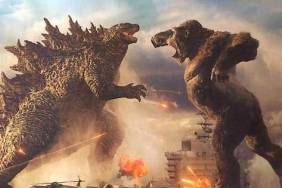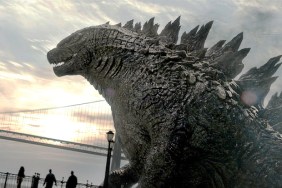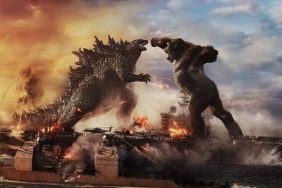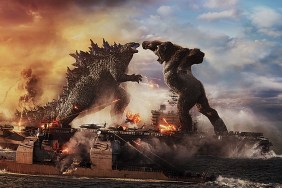Godzilla: Final Wars


Release Date: 4th December 2004
New Monster: Monster X
Description: Bone-faced, laser-eyed bipedal humanoid demon.
Origin: Created by Xilians to fight Godzilla.
Destruction: Grows and mutates into Monster XII

Description: Three-headed Ghidorah-like winged dragon fused with a demonic, bony centaur body.
Destruction: Godzilla rips all three of its heads off, stomps on it, and sets fire to the remains.
Ancillary Monsters: Manda, Gigan (later, Chainsaw Gigan), Rodan, Anguirus, Zilla, Kamacuras, Kumonga, King Caesar, Minilla, Ebirah, Hedorah, Mothra.
Actor(s): Tsutomu Kitagawa (Godzilla), Toshihiro Ogura (Anguirs, Hedorah, and Ebirah), Motokuni Nakagawa (King Caesar and Monster X), Naoko Kamio (Minilla and Rodan)
Final Wars is the second longest Godzilla film of them all, and that’s only after you count the 1998 film. It has all the bonkers elements you demand from a Godzilla film. In addition to the largest volume of monsters of any Godzilla film (there are 15 monsters in all, which is two more than the previous record holder, Destroy All Monsters), it also has evil aliens (who may or may not be robots in disguise), an invasion, and superhuman mutants who can pilot complex monster-fighting machines (including a big flying drill called The Gotengo, borrowed from the 1963 Toho film Atragon). It has humans with half-alien DNA, and a rare breed of super-duper supermutants called Keizers who can movie things with their minds. Had this film maintained the usual Godzilla tone of childish gee-whiz monster ass-kickery, then it may have been just downright awesome. Sadly, it does not, and it isn’t.

It might be fortunate that Godzilla was retired at this particular point in film history. The digital revolution was already happening, and lightweight digital cameras changed action films from hefty and well-composed action shots into swirling, quickly-edited traffic jams of imagery. As such, the film’s director Ryuhei Kitamura (The Midnight Meat Train) has made a 125-minute film that is jam-packed with fight scenes and would-be-awesome motorcycle chases which all feel choppy and cheap and dull. Indeed, the film spends so much time with invading aliens and supermutants that it takes over an hour for Godzilla to even appear. Kitamura also upped the edgy violence, presenting us with the first Japanese Godzilla film to be rated PG-13. Note to filmmakers and everyone: “edgy” does not equal “interesting.”

So every monster known to Earth has suddenly started attacking. Kamacuras is in France! Zilla (from the 1998 film) is in Australia! King Caesar has returned! Kumonga is around! The montage of invading monsters is a fun sequence for fans of the series. Meanwhile, a spaceship has appeared in the sky, and some cenobite-clad human-looking aliens called Xilians claim to be benevolent, but are clearly up to something sinister. They definitely have something to do with mutant DNA, and the recently exhumed corpse of Gigan, the buzzsaw bird last seen in Godzilla vs. Megalon. There’s just way too much story. Eventually it’s revealed that the aliens want to harvest human beings for food, and will take over the planet with their monster-control device. This all sounds cool, but, again, the stern steely aesthetic robs the film of a lot of its fun.
So it’s up to Godzilla to save the day. Also Mothra. Godzilla was freed from a glacier that he was pozen in in the 1960s, which, of course, stands counter to the other Millennium films, and may be closer in line with Godzilla Raids Again. I get the feeling that Kitamura wasn’t too interested in giant monster action, though, because Godzilla’s fights are all brief, and almost feel truncated. Like when the G Man finally shows up to kick some monster ass and keep the monsters in their place, it all happens in a montage. Godzilla kills Zilla in what is notoriously the shortest monster fight in the whole series (“I knew that tuna-eating monster was no good!” the evil Xilian leader bemoans). I like the detail that most of the monsters are guys in suits or puppets, but Zilla is still animated with CGI. The fights all take a matter of seconds. You would think this would lead to a massively awesome fight with the film’s new monster, a la Godzilla vs. Destroyah, but when Monster X shows up, it just has another brief fight. No cool battles. Just a quick blast or two, and the bad guy is down. Although Monster X does mutate into Monster XII (a.k.a. Keizer Ghidorah) which is a gigantic centaur version of King Ghidorah. The monster looks so cool, it’s a pity that Godzilla just picks him up and chucks him away.

And that’s it. Kind of a whimper of a final film. Nowhere near as epic as the Viking meltdown in Destroyah. A fun story and an epic monster mash that is all but ruined by the out-of-character filmmaking. Maybe the appearance of Minilla has something to do with it. I’ve never been fond of Minilla (Godzilla’s kewpie-faced son), and I think his presence here might just be the bad portent we needed.
This was the most expensive of all the Godzilla films to date (the 1998 film excepted), and one of the least successful. Toho had already decided to retire their monster until interest had resurged. Godzilla has lain dormant for 10 years now, and, thanks to an enterprising young English filmmaker, we’ll get another one soon enough. Let’s hope it has the spirit back.






